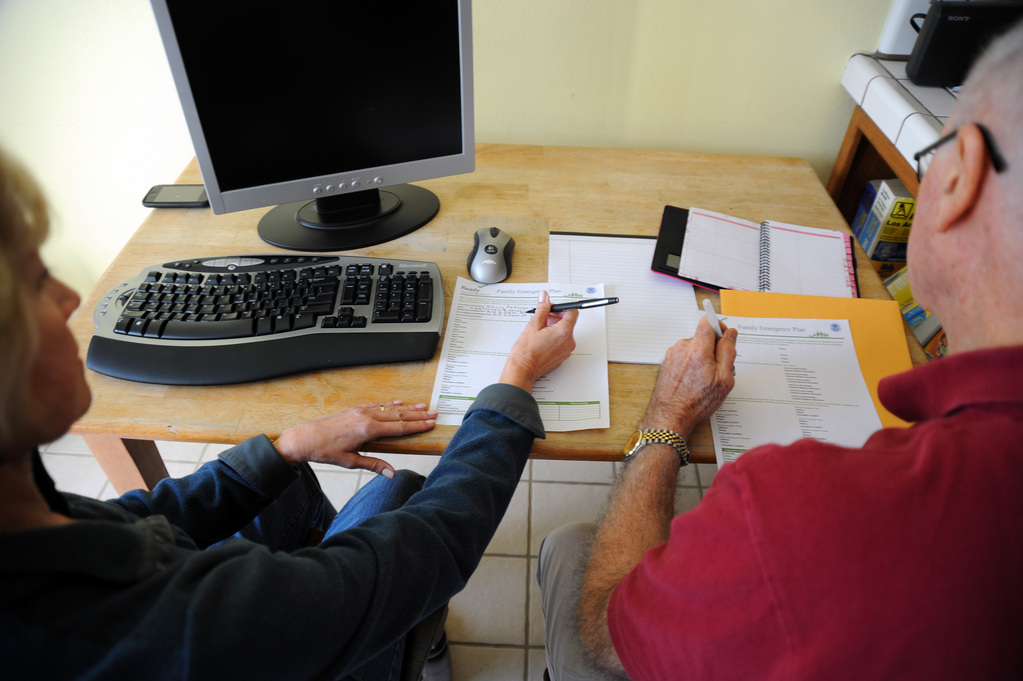How to Prepare a Home-Based Business for a Disaster

Most business continuity articles focus on how different types of commercial facilities can prepare for and recover from natural disasters and other disruptions. However, home-based businesses also should be aware of the increasing importance of business continuity planning to their bottom line. With more than half (51.6%) of small businesses in the United States now home-based according to the U.S. Census, these businesses represent a large business sector that could be vulnerable to emergencies and disasters if they lack advance plans. With that in mind, this article provides practical ideas for home-based businesses to become better prepared.
Running a Business from Home Has Never Been Easier
The progress and improvements made in communication and information technology have allowed entrepreneurs to establish an office almost anywhere. Businesses as diverse as dog-sitting services and website design firms now can be conducted right from home where customers may be closer and operating costs lower. However, having a home-based business puts even more at risk in the event of severe weather and other emergencies – losing a home and a business at the same time is double trouble for those who are not prepared. In addition, the vast majority of home-based businesses have no employees to provide back-up to the owner, meaning an unexpected injury or serious illness could be the end of a business that has not planned for the unexpected.
Planning Made Easy
Many home-based business owners focus on start-up, immediate financial needs and daily operations, not thinking about contingencies that are unlikely but possible. People who own and run a business solely from their residence need to take the same approach to risk management and business continuity planning as any business that is run from a commercial location.
To help with planning, the Insurance Institute for Business & Home Safety (IBHS) created an electronic business continuity tool intended especially for small businesses, including home-based businesses. This free toolkit, OFB–EZ™ (Open for Business-EZ), translates professional business continuity concepts into common business activities through an eight-step process that is easy to use, implement, administer and maintain. Statistics show that, of the businesses that close because of a disaster, one in four never reopens. Small home-based businesses are particularly at risk because they have all of their operations entirely in one location. Although every business needs to prepare for potential disasters, OFB-EZ is designed so those without business continuity experience or knowledge can easily understand what they need to do, and how to do it. Learn more about OFB-EZ.
Home is Where Your Business is
Home-based businesses should be aware their business is only as secure as the place they call home. While a home is a source of pride for all homeowners, it also is a critical part of business protection for home-based business owners. Therefore, it is important for them to take steps to protect their home from seasonal weather and other hazards that may affect their region. Practical suggestions for mitigating against risks as diverse as earthquake, flood, freezing weather, hail, high winds, hurricane, lightning, tornado, and wildfire can be found at www.disastersafety.org. Also available is a ZIP Code-based interactive map tool, which will help identify natural hazards that may affect a business’ location. It’s also important for business owners to make sure their home is properly maintained both inside and out and adequately upgraded to address electrical or other special needs arising from the home-based business.
Looking more broadly beyond natural disasters, it also is a good idea for home-based business owners to understand what other risks (such as theft, civil disturbance or utility outage) may threaten their business, how likely they are to occur, and their potential consequences. OFB-EZ includes a Vulnerability and Risk Assessment intended for businesses, but the exercise also may identify ways in which their home needs to be structurally strengthened or better protected. See pages 4-5 in the OFB-EZ toolkit.
Determine Home-Based Business’ Critical Functions
A recovery plan for a home-based business must focus on the things that matter most to the bottom line; therefore, the first step for owners is to identify the business’ key functions and processes, and decide how long each can be out of operation. OFB-EZ helps by providing a simple spreadsheet to document critical details for each business function, including: what equipment, software and reports are needed to perform the function; how quickly it needs to be restored; and, who receives the finished product. The planning toolkit also will help to identify and document operations failure workarounds to keep the business up and running.
It is important for owners to remember if there are no business partners or employees to rely on, a family member or close friend may be following the plan’s workaround instructions in the event the business owner is unavailable; therefore, it is imperative no small detail be left out.
No Employees? A Communication Plan Is Still Needed
Even if a home-based business does not have any employees, communication is vital during and after a disaster or disruption. Customers, suppliers and business partners need to be made aware a disruption has occurred, and for that to happen, the business owner needs to know in advance how best to contact them. Placing information on the business’ website and/or social media pages (Facebook, LinkedIn, Twitter, YouTube, etc.) will provide information to those seeking the business’ status; however, it may be more effective for the owner to reach out to important contacts directly using lists developed in advance. OFB-EZ can facilitate this by providing a convenient place to create, maintain and access up-to-date contact information. Owners should remember it is critical to update this information as the contacts change and the business evolves. See pages 8-11 in the OFB-EZ toolkit for more information.
A ‘Go Bag’ is a collection of items that are crucial to the home-based business owner. It is a collection of the bare minimum tools and possessions the owner should have ready to GO in the event of a crisis. Recommended items include:
- Cellphone or PDA containing key emergency contacts, passwords, etc. and charger
- Identification and wallet/cash/credit cards
- Keys for car, house and office
- Laptop and charger
- Calendar/day planner
- Backup tapes or drives
- Business continuity plan, disaster plan and/or emergency procedure manual in hard copy format
- Flash drive with critical documents, customer and supplier/vendor information, emergency plans/procedures, asset inventories, and credit card information (including both the front and the back of credit cards in order to access account information, expiration dates and the customer service number)
- First aid supplies
- Password book/document
- Basic office supplies (pen and paper)
- Network cables (Ethernet)
Technology – A Key Requirement in a Home-Based Business
Technology is the lifeblood that has enabled many home-based businesses to survive and thrive. Critical technologies– such as virtual private networks (VPNs), conference calling, videoconferencing, and smartphones – generally require the Internet and electricity, and are extremely vulnerable to many disruption scenarios, ranging from a localized power outage to a major natural catastrophe. It is critical for business owners to inventory and document the business’ information technology resources, including hardware, software, digital data and connectivity, and procedures for restoring service as quickly as possible. OFB-EZ helps to organize this information and discusses the importance of backing up online data frequently, off-site storage, and restoration options. See pages 12-13 in the OFB-EZ toolkit.
Keeping the Home Office Running
One way to minimize the disruption from a power outage is to invest in a backup generator, an uninterruptible power supply (UPS) system, or both. While backup generators provide long-term protection in the event of a power interruption, a UPS is designed to provide continuous power when surges and gaps occur. This will temporarily protect electronic equipment and save data by keeping computer systems running without interruption when the power fails.
Before deciding to purchase an electrical power generator and/or a UPS system, business owners should consider what electrical equipment must be operable when normal power is interrupted. Other considerations which will help determine the size and type of generator or UPS system to purchase include:
- How often does the home-based business lose power and for how long?
- What items will need electricity, e.g. lights, computers and a small air conditioner only, or larger appliances and other home office equipment?
Financial Strategies & Insurance Considerations
As is the case with operations, the time to prepare a business’ finances for a potential disaster is before it occurs. It cannot be assumed suppliers, vendors and creditors will be aware a disaster has occurred and are automatically granting extensions. A home-based business owner’s disaster financial strategy should include:
- Setting up a line of credit in advance with the bank for emergencies;
- Determining how much cash will be needed to survive a 3-day, 5-day, 10-day, or longer shutdown;
- Determining if, and how, they will be able to pay bills/accounts payable; and
- Identifying how they will continue to accept payments from customers/accounts receivable.
See pages 14-15 of the OFB-EZ toolkit for the entire financial checklist.
Although OFB-EZ is not an insurance program, it provides guidance on how to review insurance coverage with regard to what is covered, what is not covered, and available types of coverage. Because many homeowners’ policies do not cover home-based businesses or require special endorsements, it is critical for home-based business owners to speak with their insurance agent, broker or company about how best to insure the assets of a home-based business. Because each business insurance policy comes with its own limits, exclusions, deductibles, and coverages, it is important for owners to read and understand the policy in its entirety. It is a good idea for them to review insurance coverage annually (or more frequently if there are significant changes to inventory or operations) because as a home-based business grows, its risks and liabilities also will grow. Owners also should ensure policies still adequately cover all exposures so the business is not underinsured if a disaster strikes.
Lastly, as part of a financial protection plan, it is a good idea for business owners to make an inventory of the items used in the business. The Insurance Information Institute (I.I.I.) recommends taking a complete inventory of all personal business property, determining its value, and deciding what’s worth insuring. Having an up-to-date business inventory will help business owners settle insurance claims faster, verify losses for the business’ income tax return and purchase the correct amount of insurance.
Alternate Location
Even though a business may be based at home, it’s important to have an alternate location, should the home be damaged or lack essential services. The identification of an alternative workplace is an important part of a business continuity plan. This will help guarantee business will go on as close to normal as possible in the event a home office becomes unusable due to a disaster. The alternate office could be a family member or friend’s home, or even a buddy system with another home-based business owner who is not a competitor. When disaster disruption occurs at either location, one can utilize the other’s workplace as a temporary office. Ideally, the location of an alternate workplace should be conveniently accessible but not close enough that both areas can be hit by the same disaster. When relocating to the alternate location, it is imperative that a Go Bag (a collection of items crucial to the business) be ready and packed as there may be a limited amount of time to evacuate.
CREATE A BUSINESS INVENTORY
Know Your Stuff® – Home Inventory is the Insurance Information Institute’s online inventory software specifically designed for personal use but can just as easily be used for a home-based business. An up-to-date business inventory is an important component of disaster planning. When business owners create the inventory, they should include a description of each item and note where it was purchased and its make, model and serial number. When possible, attach any sales receipts, purchase contracts, and appraisals to the inventory.
To create a business inventory using Know Your Stuff – Home Inventory, visit www.knowyourstuff.org.
Conclusion: Treat a Home-Based Business Like a Big Business – Make a Plan
A disaster to a home-based business is a threat to the owner’s lifestyle and livelihood. Home-based businesses are no less vulnerable than commercial establishments, therefore a business continuity plan that reflects the unique risks facing business owners who work from home is the best way to stay at home and open for business.
About the Insurance Institute for Business & Home Safety (IBHS)
IBHS is an independent, nonprofit, scientific research and communications organization supported by the property insurance industry. The organization works to reduce the social and economic effects of natural disasters and other risks on residential and commercial property by conducting building science research and advocating improved construction, maintenance and preparedness practices. Visit DisasterSafety.org for more information about building and retrofitting homes and businesses to make them more disaster-resistant, which will help create more resilient communities.logos 062015
Find a Home-Based Business to Start-Up >>> Hundreds of Business Listings.
















































